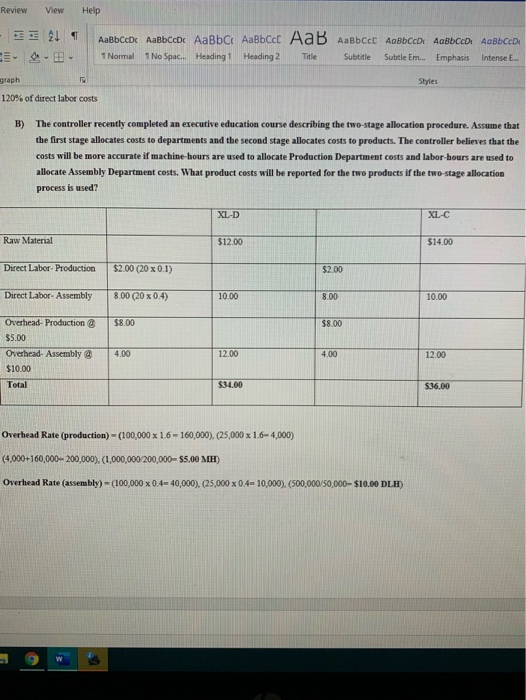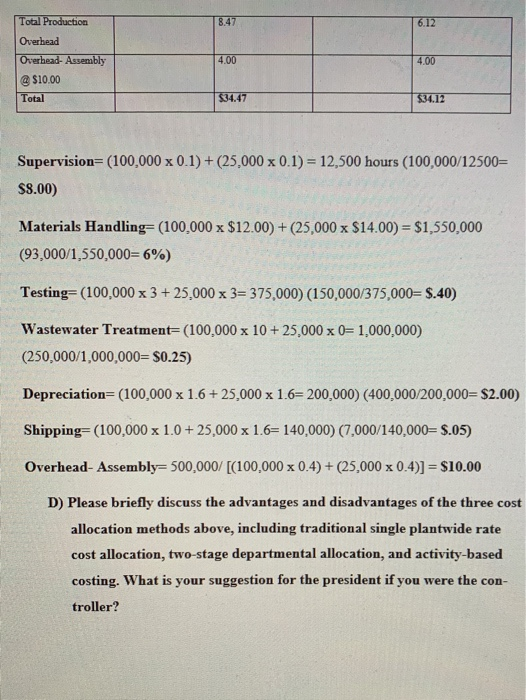Answered step by step
Verified Expert Solution
Question
1 Approved Answer
ANSWER QUESTION (D) only!! A) 3C's current cost accounting system charges overhead to products based on direct labor cost using a single plantwide rate. What




ANSWER QUESTION (D) only!!
A) 3C's current cost accounting system charges overhead to products based on direct labor cost using a single plantwide rate. What product costs will it report for the two products if the current allocation system is used? XLC T 514.00 XL-D $12.00 $2.00 (20x0.1) Raw Material Direct Labor- Production Direct Labor- Assembly Overhead @ 120% Total 8.00 (20 x0.4) 10.00 10.00 12.00 $34.00 Overhead Rate = (Production Overhead + Assembly Overhead) Total Direct Labor Cost =($1,000,000 + $500,000) [(100,000 x $10) + (25,000 x $10)] - 120% of direct labor costs B) The controller recently completed an executive education course de scribing the two-stage allocation procedure. Assume that the first stage allocates costs to departments and the second stage allocates costs to products. The controller believes that the costs will be more accurate if machine-hours are used to allocate Production Department costs and labor-bours are used to allocate Assembly Department costs. What product costs will be reported for the two products if the two-stage allo cation process is used? XC Review View Help ! AaBBCCD ABCD AaBb C AaBbcc AaB Aabbccc AaBbcAbbcc Aabbcc Normal 1 No Spac..Heading 1 Heading 2 Title Subtitle Subtle Em Emphasis intense 120% of direct labor costs 3) The controller recently completed an executive education course describing the two-stage allocation procedure. Assume that the first stage allocates costs to departments and the second stage allocates costs to products. The controller believes that the costs will be more accurate if machine hours are used to allocate Production Department costs and labor hours are used to allocate Assembly Department costs. What product costs will be reported for the two products if the two-stage allocation process is used? XL-D XL-C Raw Material $12.00 $14.00 Direct Labor- Production $2.00 (20 x 0.1) $2.00 Direct Labor. Assembly 8.00 (20 x 0.4) 8.00 $8.00 Overhead-Production $5.00 Overhead. Assembly $10.00 Total 4.00 12.00 $36.00 Overhead Rate (production) - (100,000 x 16 - 160,000). (25,000 x 1.6-4,000) (4,000+160,000- 200,000). (1,000,000/200,000-$5.00 MH Overhead Rate (assembly) -(100,000 x 0.4-40,000). (25,000 x 0.410,000). (500,000/50,000-$10.00 DLH) (4,000+160,000= 200,000). (1,000,000/200,000= $5.00 MH) Overhead Rate (assembly) -(100,000 x 0.4= 40,000). (25,000 x 0.4=10,000). (500,000/50,000= $10.00 DLH) C) The company decides to compute product costs assuming an ABC sys- tem is implemented only in the Production Department. Overhead in Assembly will continue to be allocated based on direct labor cost. The cost drivers selected for the activity-based costing system are: (Over- head Item, Driver Supervision, Direct labor-hour's, Material handling, Material cost Testing, Testing hours, Wastewater treatment, Wastewater generated, Depreciation on equipment, Machine-hours, Shipping Weight). What product costs would be reported if this ABC system were implemented? Assume that the production mix and costs would remain as originally planned. XLD $12.00 XC $14.00 1 0. 00 3 .00 10.00 Raw Materal Direct bor Production Direct Labor 3. 00 Assembly Overhead Production Supervision 30 TOBO 38.00 0.80 Material Handling @ 0.72 / / 10.5 Testing @ 30:40 1120 Waste Treatment 2350 $ 25 Depreciation & $2.00 3.20 Shipping @ 50.05 0.05 Total Production Overhead Overhead- Assembly @ $10.00 Total $34.47 Supervision=(100,000 x 0.1) + (25,000 x 0.1) = 12,500 hours (100,000/12500= $8.00) Materials Handling=(100,000 x $12.00) + (25,000 x $14.00) = $1,550,000 (93,000/1,550,000=6%) Testing=(100,000 x 3 + 25,000 x 3=375,000) (150,000/375,000= $.40) Wastewater Treatment=(100,000 x 10 + 25,000 x 0= 1,000,000) (250,000/1,000,000= $0.25) Depreciation=(100,000 x 1.6 +25,000 x 1.6=200,000) (400,000/200,000= $2.00) Shipping (100,000 x 1.0+ 25,000 x 1.6= 140,000) (7,000/140,000= $.05) Overhead - Assembly=500,000/ [(100,000 x 0.4) + (25,000 x 0.4)] = $10.00 D) Please briefly discuss the advantages and disadvantages of the three cost allocation methods above, including traditional single plantwide rate cost allocation, two-stage departmental allocation, and activity-based costing. What is your suggestion for the president if you were the con- troller Step by Step Solution
There are 3 Steps involved in it
Step: 1

Get Instant Access to Expert-Tailored Solutions
See step-by-step solutions with expert insights and AI powered tools for academic success
Step: 2

Step: 3

Ace Your Homework with AI
Get the answers you need in no time with our AI-driven, step-by-step assistance
Get Started


